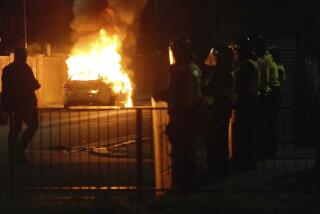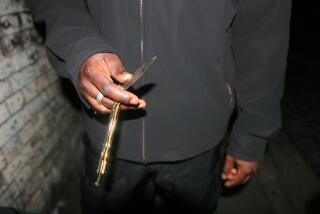EUROPE : Armed Bobbies Spur Debate Among Britons : The citizenry has prided itself on constables who keep order with only a billy club and a smile. But criminals’ use of weapons is rising, and some police can now carry guns.
- Share via
LONDON — The British have long prided themselves on having a virtually unarmed police force--a national symbol of civility and order.
The traditional bobby in his funny helmet was armed only with a billy club and a smile--in sharp contrast to the gunslinging cops in U.S. and continental European police forces.
For the record:
12:00 a.m. May 21, 1994 For the Record
Los Angeles Times Saturday May 21, 1994 Home Edition Part A Page 4 Column 1 National Desk 1 inches; 20 words Type of Material: Correction
Britain’s bobbies: An article in Friday’s editions incorrectly identified the commissioner of Britain’s Scotland Yard. He is Paul Condon.
But in recent years, criminals--particularly in Britain’s inner cities--increasingly have been using weapons. Public pressure to arm the police has mounted, and this week Scotland Yard provoked controversy by permitting some police to carry guns.
The Metropolitan Police Force (Scotland Yard’s official name), declared that members of specialist teams could wear guns in holsters and increased from five to 12 the number of its armed-response vehicles (ARVs).
Previously, police in ARVs needed authorization from a high-ranking officer before they could remove guns from a locked box, a process that often hindered the interception of criminals.
Police authorities also announced that bobbies nationwide may soon abandon their traditional 19th-Century nightsticks in favor of U.S.-style telescoping batons, which with a flick of a wrist extend the reach of the weapon. The government hopes that introduction of the modern baton will dilute calls for the routine arming of Britain’s police.
Some civil rights activists have opposed an increase in the number of armed police. Currently in London, only 1,888 of 28,000 police are armed and they mostly belong to diplomatic protection and other specialist groups, whose weapons are concealed.
Atiya Lockwood of the civil liberties group Liberty said the move was “dangerous and undemocratic.” She added, “There is no evidence people will be safer. More innocent people will be shot.”
Even many police officers believe that only highly trained specialists should be armed. An official of the Police Federation, which represents 126,000 officers nationwide, explained: “The federation is against the routine arming of police and the open wearing of guns. It is in favor of limited specialist training.”
The official cited a recent Gallup Poll of 1,000 members of the public and 2,000 police constables showing that fewer than half the officers responding favored wider arming.
The sharpest difference of opinion arose between officers in the inner cities and their colleagues in rural areas. In London, 63% wanted ready access to guns, while in the countryside, two-thirds of those officers polled wanted no more armed police.
Fully 31% of officers surveyed said they were not “psychologically” equipped to carry weapons. Many said they would not be trained well enough to handle weapons and might lose them in a confrontation with armed criminals, the Police Federation official said.
Other objections ranged from the danger of accidents to the possibility the change would in turn give criminals a greater excuse to carry guns.
Further, according to the Assn. of Chief Police Officers, the number of armed assaults on police has remained fairly static, with only about two officers killed on duty annually.
Scotland Yard Commissioner Paul Watson says that routine arming of officers has not dramatically improved safety anywhere in the world. “If everyone has to wear a gun there would be no high standards,” he said. “We have restricted the training and issue of firearms to highly trained and capable police officers.”
However, the slayings of two police officers and wounding of others in the London area in the past year prompted a public outcry for equipping constables with better protection.
Two-thirds of civilian respondents in the Gallup survey believed that officers should carry or have instant access to firearms.
Police officers, the public and politicians agree that officers should receive a wider range of protective equipment, including the longer batons and body armor. Some favor pepper-spray guns, which are not authorized.
Fred Broughton, chairman of the Police Federation’s constables committee, declared: “We need better protection and we need it right now. The public is right behind us. They’ve seen us take unacceptable casualties over the course of the past few years and their message is the same as ours: Enough is enough. Protect the thin blue line; otherwise society will have no protection.”
And Commissioner Watson, who has not ruled out eventual arming of all his officers if he can’t get sufficient other defensive measures, added: “I think we all value the traditional image of the British bobby.
“But we have to police the real world. Having had officers murdered, shot and stabbed, I am not prepared to ask my officers to carry out their duties without better protection.”
Law Enforcement’s Armed Opponents
Crimes committed with firearms in two of England’s largest urban centers.
1989 1990 1991 1992 1993 Metropolitan London 2,640 2,739 3,691 3,568 3,722 Greater Manchester 458 557 707 880 1,048
Nationwide, the number of operations in which armed police were dispatched rose from 2,185 in 1987 to 3,722 in 1991.
SOURCE: British Home Office
More to Read
Sign up for Essential California
The most important California stories and recommendations in your inbox every morning.
You may occasionally receive promotional content from the Los Angeles Times.













